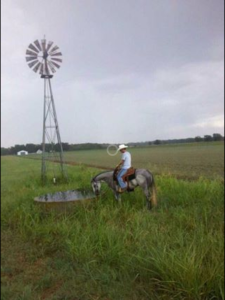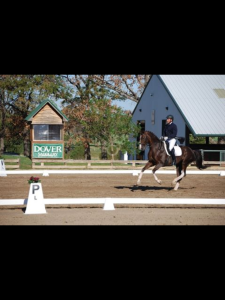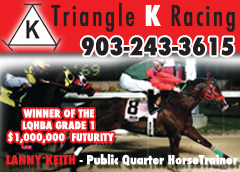Original Publish Date February 2014.
Matt Cunningham, dressage rider and clinician, is giving a lesson to Paige Hewlett at Holly Hill Farm in Benton, Louisiana. Paige is riding Tobey, a lanky dark bay Oldenburg. Tobey is having a hard time controlling his body as he transitions from trot to canter and back again. Matt explains to Paige that Tobey, like many young horses, is tracking crookedly because his stride is big and he doesn’t want to step on himself. Nevertheless, Tobey must practice coming “through” with his inside hind and carrying himself straight.
 “Move him away from your left leg and back into the left lead. Don’t let him push against you. Tap him away from your left leg and push him—you’ve got to make that left hind jump through. Now back to trot, back to trot, giving, giving, giving with the reins. Organize him—turn left, go straight down centerline, leg yield, right leg on, canter right when you get to the track. Now keep the right leg as you go into trot. Push with the right leg and yield him into trot. Now he’s coming through with the right hind. Soft, soft with the inside rein. And walk, give him a break.”
“Move him away from your left leg and back into the left lead. Don’t let him push against you. Tap him away from your left leg and push him—you’ve got to make that left hind jump through. Now back to trot, back to trot, giving, giving, giving with the reins. Organize him—turn left, go straight down centerline, leg yield, right leg on, canter right when you get to the track. Now keep the right leg as you go into trot. Push with the right leg and yield him into trot. Now he’s coming through with the right hind. Soft, soft with the inside rein. And walk, give him a break.”
Matt connects with the rider stride by stride. He seems to be riding the horse right with you. Dressage riders can tie themselves in knots by “overthinking” their cues and the ways their horses are responding. With Matt, you relinquish control in the best way, and the result is new muscle memory and new understanding.
When Tammy Glenn and her huge, quiet Hanoverian mare enter the arena for their session, Matt sizes up the pair and decides the mare is steady enough for him to spend time on Tammy’s position. He asks her to exaggerate her shoulder placement—“Point your shoulder at her rump!”—to help her get the human back straight, and therefore the equine back straight. “Step into the right stirrup—you’re collapsing into the right hip,” he says. “There! You’re fine. Now carry that straight back right into sitting trot.”
“Feels great,” says Tammy. Her horse looks great, too. The trot is much improved.
Matt takes a break for a second and pops open a can of Diet C*k*. He grins at the auditors. “I don’t know how many this is,” he says. “I drink toxic levels of this stuff. I’ve heard that the aspartame affects short-term memory, but that’s OK. If I have a bad ride, I’ve forgotten it by the time I get back to the barn!” He looks up and catches Tammy, frustrated, trying to fix a canter transition. “Doesn’t matter,” he says calmly. “Slow down, take your time, and fix it.”
Later on in the afternoon Matt gets on my husband George’s Oldenburg mare Hattie. She’s feeling a bit unwilling to concentrate today, and Matt makes her trot forward strongly. At the same time he asks her for a slight shoulder-in on the twenty-meter circle. Hattie thinks that’s a bad idea and braces her side against Matt’s leg. Matt moves her over with a good “oomph” of his calf and he instantly gives up the inside rein when she obeys.
I suddenly realize why Matt’s teaching and riding style seems so familiar. Years ago I attended a Hilda Gurney clinic (US Olympic dressage competitor in 1976 and 1984) and I was impressed with her ability to correct a horse instantly and without anger. When Hilda corrected a disobedience, the incident was over… no hard feelings. And she rewarded just as fast. One horse she was riding that day, an opinionated Trakehner mare, kicked out when Hilda used the whip to reinforce the leg cue. Hilda swiftly turned around in the saddle and gave the horse’s offending hindquarter a whack—and when the horse kicked out at THAT correction, Hilda did it again, just as fast…and immediately turned back around and offered a giving rein. The horse settled right back into productive work. At the lunch break I mentioned to Hilda that I was awestruck by her ability to remain calm when training a horse, and still have swift reactions. Hilda said, “I have taught developmentally disabled children. If you wait more than a second to correct or praise, many of those children don’t know what the correction or praise is for. Just like horses. You correct instantly, then all is forgiven.”
When Matt and I sit down to talk that evening (after twelve hours of lessons!), I discover the clue to his approach to dressage.
“I am one of the four resident instructors at Twinwood Equestrian Center in Simonton, Texas. I specialize in dressage. Most of our boarders are dressage riders; we have some eventers and fox hunters, too,” he begins.
But right away I realize that Matt got his start in the horse world in an unusual way.
 “My fifth-grade Sunday school teacher in Longview, Texas, was and still is the director of Windridge Therapeutic Equestrian Center in Gilmer, Texas. As part of the class, we had a couple of field trips out there. I was hooked. The summer after my sixth grade year I started volunteering at Windridge, and continued all through high school. After the riding classes were done, we volunteers would get lessons, if there was time. Those horses taught me a lot. We rode English, but the instruction was really based on overall horsemanship. Windridge gave me my foundation.”
“My fifth-grade Sunday school teacher in Longview, Texas, was and still is the director of Windridge Therapeutic Equestrian Center in Gilmer, Texas. As part of the class, we had a couple of field trips out there. I was hooked. The summer after my sixth grade year I started volunteering at Windridge, and continued all through high school. After the riding classes were done, we volunteers would get lessons, if there was time. Those horses taught me a lot. We rode English, but the instruction was really based on overall horsemanship. Windridge gave me my foundation.”
That Sunday-school teacher was Margo Dewkett, who just received the 2013 EQUUS Humanitarian Award from the United States Equestrian Federation. She started the Windridge program in 1988, and Matt became a volunteer in 1992.
When Matt was in seventh grade, Margo started a riding program for a diversionary group in the juvenile detention center. “Diversion” takes at-risk juveniles who have committed relatively insignificant crimes out of the juvenile justice system. Research has shown that “labeling” minor offenders as deviant members of society may actually increase the likelihood of criminal behavior. In 1967 a national directive called for communities to create alternative programs. Besides rescuing youth from being defined as “criminals,” diversion also eases crowding in the courts.
“We would take a group of eight boys who had been incarcerated. We’d hold group sessions, talking about life, that kind of stuff, really just hanging out with them. On Fridays they’d do work around the farm and ride.” With his experience with at-risk youth at Windridge, at age seventeen he started the equestrian program for the Azleway Boys Ranch in Tyler, Texas.
Matt says, “At Azleway, I had assistance from a licensed psychologist and counselors. It was a group effort. I built the riding program from the ground up. We fenced in 40 acres, built the barn, got the horses, and trained them. We worked with sixty kids a week. That was a blast!”
At the age of nineteen Matt went on to start a similar program at the Boys Ranch of the Methodist Children’s Home in Waco, Texas. The Boys Ranch covers 1500 acres and runs a Future Farmers of America program. When Matt got there, they had goats, pigs, steers, chickens, and horses, too, but they weren’t really utilizing the horses. Matt started training horses and kids. He says, “Those kids were the first kids I actually took to dressage shows. These inner city kids, most of them hadn’t ever seen a horse. They’d show on ranch horses, and most of them did quite well, at Intro, Training, and First Level dressage.”
I ask Matt about the changes the kids would experience as they learned horsemanship. “You can’t hide much on a horse. The horse is going to totally tell on you. That’s what I enjoy most about horses. If you’re a total wreck on the inside, the horse is going to exhibit something of the same nature. Being a horseman, I can read the horse, and get an idea of what’s going on with the kid. These kids that have been on the street, in gangs, involved with substance abuse, they think they grow up tough, and by the time they’re fifteen or sixteen they think they’re grown men, the toughest guys on the block. Then they get on a 1300 pound animal and they turn into little kids again. The horse breaks down that false barrier. They all feel terribly vulnerable. You get to see the kid who never got to be a kid.”
I compliment Matt and tell him that his commands are very clear, very motor-oriented: use this leg, move the horse’s shoulders, sit straight. Matt says, “I don’t handle a lot of fluff and chatter very well.” Matt reflects that a lot of teachers do use motor commands, but some of them aren’t really riding the horse along with you, stride by stride. “It’s like they’re reading from a cookbook.”
Matt’s first dressage barn was Tex-Over Farms in Conroe, Texas, where he rode with Paul Kathen. “Paul taught me a lot,” says Matt, “but I learned the most from Paul’s educated horses.” Matt confesses that he was awful in school. “The last thing I wanted to do was focus on studying.” But with horses, Matt discovered that he was passionate about learning. “Watching and observing the best riders is probably the best teacher I’ve had.” Matt spends hours in the evening watching YouTube videos of famous riders. “I also listen to everybody,” he says. “You can always pick up something…even if it’s something you’d never do!”
Matt rides regularly with his good friend David Blake, who works at Steffen Peters’ barn near San Diego. “We have similar ways of riding. David jokes that teaching me is like teaching himself. He knows what I’m going to do before I do it!” Matt has also trained with Peters, Colonel Albrecht von Ziegner, and Jan Ebeling.
“I owe the beginnings of my career to Don’t Worry, a Westphalian who was imported as a six-year-old. ‘Dino’ was pretty fractious and hot. He was difficult at horse shows, when he was doing First and Second Levels. He’d stand up in the dressage arena, buck, and bolt. After much hard work, Dino went undefeated for three seasons, from third level to Prix St. George. He showed Intermediaire 1 twice, and then he had an injury in the paddock; it destroyed the cartilage in his right stifle. He’s had surgery and stem cell therapy, the whole gamut. I still get him out and play with him, but his competition career is done. I say I owe my career to him because he really got me noticed in the show ring; first for his brilliant naughtiness, and then just his brilliance. He was the first horse I really taught the Grand Prix movements to: pirouette, piaffe, and passage.” Matt says Dino had wonderful presence and expression.
I ask Matt what finally got through to Dino and turned the horse into a partner. “Horsemanship and repetition; management and work. I believe that we dressage riders often over-focus: we do this movement, this test, and we forget to be horsemen. I’m somewhat against specializing in one discipline: that’s why I enjoy teaching eventers and people who just go ride.”
Matt owns two horses. He has a sixteen-hand mare who has even more talent than Dino, but he has realized that she doesn’t totally fit him. “She has a small frame, and I need a bigger-bodied horse.” He also has a little Quarter Horse mare that he loves to do reining on. Twinwood has a lot of acreage, and Matt loves to do ranch stuff on her. “She’s sturdy, even though she’s small. I pony young horses off of her.”
Matt is optimistic about the future of dressage in this country. In the past, the event riders that he taught were only eager to learn enough dressage to get better placings at three-day competitions. “I don’t have any students these days that I get that feeling from.” Because of his interest in reining, he’s become buddies with some reining trainers in the Houston area, and they’re interested in learning dressage to help them with their own discipline. “People are realizing how beneficial this schooling is,” he says.
Matt wants Western riders to know that dressage is about much more than the goofy-looking stretch pants, the braids, and “that long tuxedo-looking thing.” The purpose of dressage is not to show, but to bring a horse along in such a way that it is useful for the longest amount of time. “The stallions at the Spanish Riding School in Vienna are still doing Grand Prix movements when they’re in their twenties,” he says. “If you’re really ‘about the horse,’ and about being smart, you will want the horse to last a long time. The big issue with some other disciplines,” says Matt, “is that the horse is finished at age three or four. Some horses can’t handle the pressure and break down. The trainers I know are interested in taking their time. They realize that dressage is ahead of the game in accomplishing what they are trying to do.”
Matt believes that dressage people have a lot to learn from people who are training a horse to do a job. “It’s a little irritating to go to a dressage show and find that you can’t even pull a Snickers bar out of your pocket. If the footing’s not perfect, or there’s a kid running around, or, Heaven forbid, a dog, some of these dressage horses can’t handle it. It’s ridiculous! Let’s face it: dressage has a 2000-year history of training horses to go to war. I wouldn’t want to go to war on most dressage horses today!”
“Most of my horses are started in a stock saddle. I think it spreads out the rider’s weight and spares the horse’s back. I like to ride them around outside for ninety days, get them broke first, and then go into the arena for the dressage stuff. I want a horse that’s reliable.”
Matt’s philosophy of training—take the best of all worlds, and keep the horse’s well-being uppermost—is reflected in his techniques for teaching the flying change. He doesn’t always wait until Third Level, when it first appears in dressage tests, to teach it. “It’s one of the most natural things for a horse, and counter canter is one of the most unnatural. To force an issue with a young horse, to say ‘Do this unnatural thing, and later on do the natural thing’—which is the flying change—that makes no sense to me. Second Level, which has a lot of counter canter, is tough.” Matt does find counter canter useful with horses that need straightening, balance, or strength, or for obedience with older horses that already know the changes.
“If a young horse offers a change, I let him,” says Matt. “After a horse can do shoulder-fore [a shallow shoulder-in] in both directions, I do big figure eights out in the field, up off the back, nice forward canter, and just ask. It’s not rocket science! It’s very natural. If a horse is strung out, I will use simple changes [canter-walk-canter] to prepare for the flying change. Most horse that I’ve had difficulty teaching the flying change to either have done too much counter canter or have deficient canters. Typically I go for the most natural thing with a young horse. I don’t want to micro-manage them.”
Matt does micro-manage a rider’s aids during a lesson, but in that case his attention to detail is welcome. Nevertheless, one of his most-repeated sayings is “Doesn’t matter!” Usually a rider hears him say “Doesn’t matter!” after a horse has fallen out of the canter into the trot, or has overshot a centerline, or has missed a change. It’s Matt’s shorthand for his philosophy: forgive quickly, try again correctly, and enjoy the journey.





